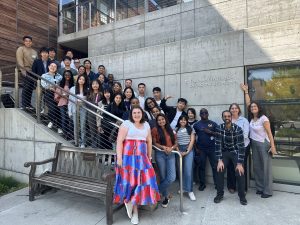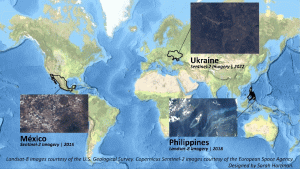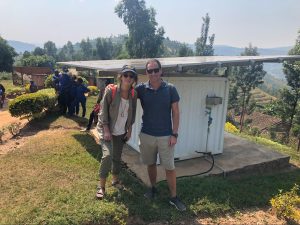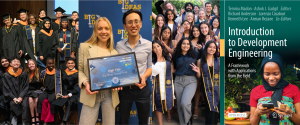 Author:
Author:
Luis Flores
On a rainy Wednesday evening, 23 UC Berkeley students from a broad range of disciplines gathered for class in a seminar room in the imposing University Hall—each taking a seat around a mysterious “Hello Kitty” stuffed doll. After a few minutes, the table was filled with seemingly unrelated products: cartoon toothpaste and toothbrush sets, a doggy-bag dispenser and a manicure set.
The lesson of the week was the potential of “bundling” products and services in public health. Creatively integrated with a colorful first-aid kit, the “Hello Kitty” emergency stuffed doll illustrated a way to incentivize the adoption of responsible health practices using cultural tastes. It is no surprise that a course focused on developing innovative solutions is taught creatively as well.
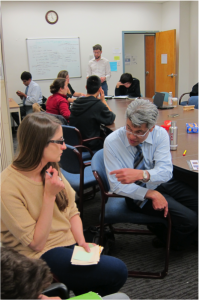 Often described as one of the most innovative courses on campus, Designing Innovative Public Health Solutions, a course sponsored by Blum Center, gives students an invaluable opportunity to engage with real clients in developing cutting edge solutions to real public health problems. “There are a lot of opportunities to do things much better,” explained course instructor Jaspal Sandhu, who holds degrees from MIT and UC Berkeley.
Often described as one of the most innovative courses on campus, Designing Innovative Public Health Solutions, a course sponsored by Blum Center, gives students an invaluable opportunity to engage with real clients in developing cutting edge solutions to real public health problems. “There are a lot of opportunities to do things much better,” explained course instructor Jaspal Sandhu, who holds degrees from MIT and UC Berkeley.
He said the course was designed to address a “need for applied skills” in approaches to public health. The course imparts the innovative approach of understanding problems, not from a theoretical perspective, but from the perspective of practitioners and recipients of public health. “We often design a good fix to the wrong problem,” lamented Jaspal.
Course co-instructor Nap Hosang, lecturer of Community Health and Human Development, advises students on their projects.
Andrea Spillmann, who recently received her MPH, was among the first group of students to enroll in Jaspal’s course. “Most of our other courses teach you what’s been done and why and how,” Andrea remarked, “either teaching you how to replicate that or why you should not replicate that.” While Andrea finds those skill sets helpful, the course on Designing Innovative Public Health Solutions helped her critically approach the root of problems and to reframe both problems and solutions in unconventional ways. Andrea’s project reflects this critical approach.
 Working with Tal Amiel, an MPP candidate, Andrea began working with Tekla Labs to develop cheaply and readily available blueprints for lab equipment in Nicaragua. However, after traveling to Nicaragua for a pilot program, Andrea and Tal noticed problems overlooked by their clients. “We noticed a drawer full of pipettes, unused because no one knew how to calibrate them,” recounted Andrea. It became apparent that health labs in Nicaragua did not need more equipment but needed to maintain and fix the equipment they already had.
Working with Tal Amiel, an MPP candidate, Andrea began working with Tekla Labs to develop cheaply and readily available blueprints for lab equipment in Nicaragua. However, after traveling to Nicaragua for a pilot program, Andrea and Tal noticed problems overlooked by their clients. “We noticed a drawer full of pipettes, unused because no one knew how to calibrate them,” recounted Andrea. It became apparent that health labs in Nicaragua did not need more equipment but needed to maintain and fix the equipment they already had.
Andrea and Tal then redirected their efforts at a more pressing problem, proposing the development of videos, plans, and a hotline to connect labs in Nicaragua with experts elsewhere who could give them advice on how to maintain equipment.
Photo Credit: Jaspal Sandhu
This semester in Jaspal’s class, students are working in groups on seven different projects, ranging from the development of a prototype investment module for drinking water franchises in rural Mexico to an initiative to increase MediCal enrollment in California’s Santa Clara Valley.
Taking about an hour of the three-hour class, guest lectures who are innovators in different industries introduce students to creative practitioners in different fields. Guests have included Chris McCarthy, a Kaiser Permanente innovation specialist who is behind the popular KP MedRite sash—which reduces medical errors in hospitals by creating “no-interruption” wear to minimize distractions in the administrating of medication.
Another inspiring lecture by a New York Times author showed the success for channeling youth rebellion away from smoking. By showing how tobacco companies work to manipulate the youth, a pioneering campaign to promote youth rebellion against tobacco companies became highly effective in reducing teenage smoking.
If the past is any indicator, students will continue to be drawn to the course, which “turns traditional analysis completely inside out,” as Ruco Van Der Merwe, a current student in the course, explained. Perhaps just as important, the course will help develop a new community of professional practitioners in public health who are unafraid to critically engage with traditional paradigms and who are poised to innovate for the public good.


